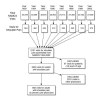Patient characteristics and clinical management of patients with shoulder pain in U.S. primary care settings: secondary data analysis of the National Ambulatory Medical Care Survey
- PMID: 15691370
- PMCID: PMC549528
- DOI: 10.1186/1471-2474-6-4
Patient characteristics and clinical management of patients with shoulder pain in U.S. primary care settings: secondary data analysis of the National Ambulatory Medical Care Survey
Abstract
Background: Although shoulder pain is a commonly encountered problem in primary care, there are few studies examining its presenting characteristics and clinical management in this setting.
Methods: We performed secondary data analysis of 692 office visits for shoulder pain collected through the National Ambulatory Medical Care Survey (Survey years 1993-2000). Information on demographic characteristics, history and place of injury, and clinical management (physician order of imaging, physiotherapy, and steroid intraarticular injection) were examined.
Results: Shoulder pain was associated with an injury in one third (33.2% (230/692)) of office visits in this population of US primary care physicians. Males, and younger adults (age < or = 52) more often associated their shoulder pain with previous injury, but there were no racial differences in injury status. Injury-related shoulder pain was related to work in over one-fifth (21.3% (43/202)) of visits. An x-ray was performed in 29.0% (164/566) of office visits, a finding that did not differ by gender, race, or by age status. Other imaging (CT scan, MRI, or ultrasound) was infrequently performed (6.5%, 37/566). Physiotherapy was ordered in 23.9% (135/566) of visits for shoulder pain. Younger adults and patients with a history of injury more often had physiotherapy ordered, but there was no significant difference in the ordering of physiotherapy by gender or race. Examination of the use of intraarticular injection was not possible with this data set.
Conclusion: These data from the largest sample of patients with shoulder pain presenting to primary care settings offer insights into the presenting characteristics and clinical management of shoulder pain at the primary care level. The National Ambulatory Medical Care Survey is a useful resource for examining the clinical management of specific symptoms in U.S. primary care offices.
Figures

References
-
- Felson DT, Meenan RF, Dayno SJ, Gertman P. Referral of musculoskeletal disease patients by family and general practitioners. Arthritis Rheum. 1985;28:1156–1162. - PubMed
-
- Cherry DK, Woodwell DA. National Ambulatory Medical Care Survey: 2000 summary. Adv Data. 2002:1–32. - PubMed
-
- Statistics NCH. Public Use Micro-Data File Documentation, National Ambulatory Medical Care Survey, 1999. Hyattsville, MD, National Technical Information Service; 2001.
MeSH terms
LinkOut - more resources
Full Text Sources

